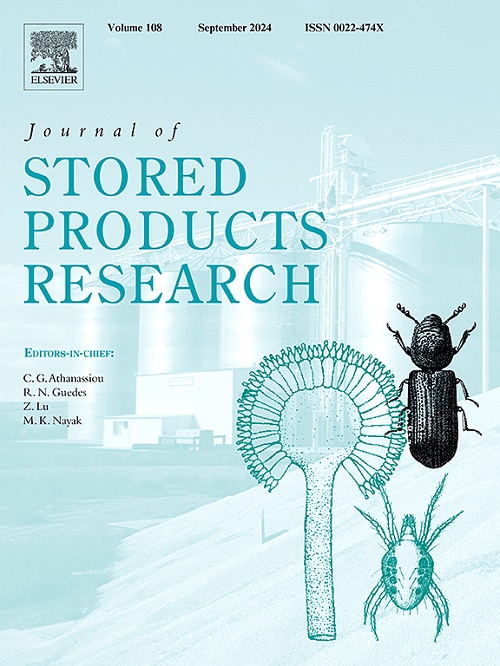香芹酚对蓖麻虫的杀虫活性和系统见解:乙酰胆碱酯酶抑制、氧化应激和分子对接
IF 2.7
2区 农林科学
Q1 ENTOMOLOGY
引用次数: 0
摘要
香芹酚是一种有效的防虫剂,对多种农业害虫具有显著的生物活性。本研究旨在探讨香芹酚作为一种有效的防虫剂对蓖麻虫成虫和幼虫的作用机理。该研究包括对香芹酚毒性、生化改变和扫描电镜观察的评估。此外,还对香芹酚的杀虫机理进行了分子对接研究。接触毒性试验显示,成虫和幼虫的LC50分别为30.95 mg/mL和8.08 mg/mL,死亡率均显著。Carvacrol处理导致还原性谷胱甘肽(GSH)、超氧化物歧化酶(sod)和谷胱甘肽过氧化物酶(GPx)水平显著降低,而丙二醛(MDA)水平升高。此外,香芹酚还能抑制乙酰胆碱酯酶(AChE)活性。扫描电镜显示处理后的幼虫形态异常,包括松弛、变形、角质层收缩和生殖器乳头变形。对接分析表明,香芹酚对castaneum中特定蛋白具有高亲和力,支持其杀虫潜力。值得注意的是,谷胱甘肽s -转移酶(GST)对香芹酚的结合亲和力最强,结合能为−6.4 kcal/mol。毒死蜱对目标活性位点没有亲和力。与毒死蜱相比,香芹酚对乙酰胆碱的结合亲和力更强(−7.1 kcal/mol)。然而,这两种化合物对尼古丁单核苷酸显示出相同的结合亲和力。Carvacrol对microRNA 20b的结合亲和力为−4.3 kcal/mol,低于毒死蜱对microRNA 20b的结合亲和力(−5.1 kcal/mol)。与毒死蜱相比,香芹酚对细胞色素P450酶具有更强的结合亲和力。值得注意的是,两种化合物对气味结合蛋白的结合亲和力相同,为−5.2 kcal/mol。总之,这些发现突出了香芹酚作为一种有效的生物防治剂对castaneum的潜力。这种潜在的杀虫活性是由其毒性、抑制GST活性、抑制细胞色素P450酶以及抑制microRNA和AChE活性的能力所支持的。本文章由计算机程序翻译,如有差异,请以英文原文为准。

Insecticidal activity and systematic insights of carvacrol against Tribolium castaneum: Acetylcholinesterase inhibition, oxidative stress, and molecular docking"
Carvacrol is a potent insect control agent with significant bioactivity against various agricultural pests. This study aimed to investigate the mode of action of carvacrol, an effective insect control agent, against Tribolium castaneum adults and larvae. The study included assessments of carvacrol toxicity, biochemical alterations, and scanning electron microscopy observations. Additionally, molecular docking studies were performed to predict the insecticidal mechanism of carvacrol. The contact toxicity assay revealed significant mortality rates for both adults and larvae, with LC50 values of 30.95 mg/mL and 8.08 mg/mL, respectively. Carvacrol treatment resulted in a significant decrease in the levels of reduced glutathione (GSH), superoxide dismutases (SODs), and glutathione peroxidase (GPx), while increasing malondialdehyde (MDA) levels. Additionally, carvacrol inhibited acetylcholinesterase (AChE) activity. Scanning electron microscopy revealed morphological abnormalities in treated larvae, including flaccidity, deformation, cuticle shrinkage, and genital papillae deformation. The docking analysis showed that carvacrol has a high affinity for specific proteins within T. castaneum, supporting its insecticidal potential. Notably, Glutathione S-transferase (GST) demonstrated the strongest binding affinity for carvacrol with a binding energy of −6.4 kcal/mol. In contrast, chlorpyrifos showed no affinity for target active sites. Carvacrol exhibited a stronger binding affinity for AChE (−7.1 kcal/mol) compared to chlorpyrifos. However, both compounds displayed equivalent binding affinities for nicotine mononucleotides. Carvacrol showed a binding affinity of −4.3 kcal/mol for microRNA 20b, which was lower than the binding affinity of chlorpyrifos (−5.1 kcal/mol) for microRNA 20b. Carvacrol demonstrated a stronger binding affinity for cytochrome P450 enzymes compared to chlorpyrifos. Notably, both compounds exhibited an identical binding affinity of −5.2 kcal/mol for odorant-binding protein. In conclusion, these findings highlight carvacrol's potential as an effective biocontrol agent against T. castaneum. This potential insecticidal activity is supported by its toxicity, inhibition of GST activity, suppression of cytochrome P450 enzymes, and its ability to inhibit microRNA and AChE activity.
求助全文
通过发布文献求助,成功后即可免费获取论文全文。
去求助
来源期刊
CiteScore
5.70
自引率
18.50%
发文量
112
审稿时长
45 days
期刊介绍:
The Journal of Stored Products Research provides an international medium for the publication of both reviews and original results from laboratory and field studies on the preservation and safety of stored products, notably food stocks, covering storage-related problems from the producer through the supply chain to the consumer. Stored products are characterised by having relatively low moisture content and include raw and semi-processed foods, animal feedstuffs, and a range of other durable items, including materials such as clothing or museum artefacts.

 求助内容:
求助内容: 应助结果提醒方式:
应助结果提醒方式:


